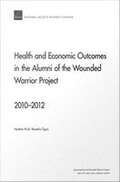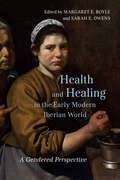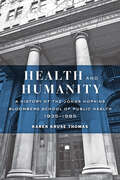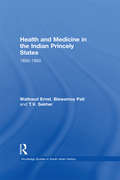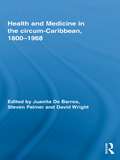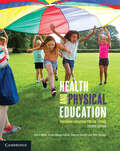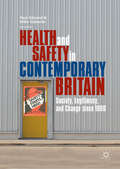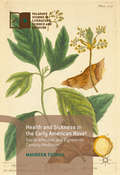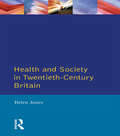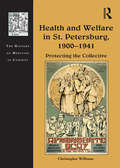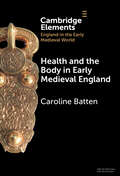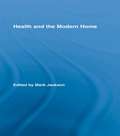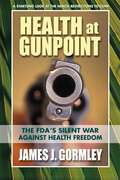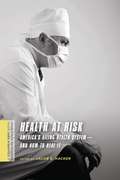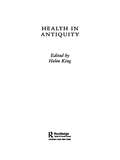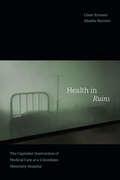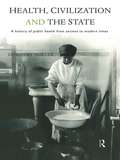- Table View
- List View
Health and Economic Outcomes in the Alumni of the Wounded Warrior Project: 2010-2012
by Mustafa Oguz Heather KrullThe Wounded Warrior Project has developed programs to help care for injured service members and veterans. This report describes how project alumnus respondents are faring in domains related to mental health and resiliency, physical health, and employment and finances.
Health and Healing in Early Modern England: Studies in Social and Intellectual History (Variorum Collected Studies)
by Andrew WearThe opening studies in this volume, on the revival of Galenic medicine in Continental Europe, provide the context for its focus - England in the 17th century. The author covers the discovery of the circulation of the blood, but it is the underlying components of health and medicine that form the subjects of this book. It deals, notably, with the strong link then perceived between health and the environment, perhaps even more present in people’s minds than today, with the relationship between medicine and religion, and with medical ethics. Further studies discuss the provision made for the sick poor, the popularisation of medicine, and the epistemological basis of learned or university based medicine. A theme throughout is the range of treatments available in the ’medical marketplace’ of the 17th century, from wise women to learned physicians.
Health and Healing in the Early Modern Iberian World: A Gendered Perspective (Toronto Iberic)
by Sarah E. Owens Margaret E. BoyleRecognizing the variety of health experiences across geographical borders, Health and Healing in the Early Modern Iberian World interrogates the concepts of "health" and "healing" between 1500 and 1800. Through an interdisciplinary approach to medical history, gender history, and the literature and culture of the early modern Atlantic World, this collection of essays points to the ways in which the practice of medicine, the delivery of healthcare, and the experiences of disease and health are gendered. The contributors explore how the medical profession sought to exert its power over patients, determining standards that impacted conceptions of self and body, and at the same time, how this influence was mediated. Using a range of sources, the essays reveal the multiple and sometimes contradictory ways that early modern health discourse intersected with gender and sexuality, as well as its ties to interconnected ethical, racial, and class-driven concerns. Health and Healing in the Early Modern Iberian World breaks new ground through its systematic focus on gender and sexuality as they relate to the delivery of healthcare, the practice of medicine, and the experiences of health and healing across early modern Spain and colonial Latin America.
Health and Healthcare Policy in Italy since 1861: A Comparative Approach
by Francesco TaroniProviding a historical overview of healthcare in Italy from its unification in 1861 to the present COVID-19 pandemic, this book analyses the political, social and cultural impact of Italian healthcare policy and medicine. The author examines the development of public health, hospitals, and primary care, and the building of healthcare systems across three political regimes in Italy: the liberal period (1861-1914), Fascism (1922-43), and the Italian Republic (1948 to the present day). By emphasising the embeddedness of health-related legislation in Italy’s political and social background, this book offers a comparative account of Italian health policy, and contrasts this with developments in neighbouring European countries, Canada and the United States. The book focuses on the Italian government’s reaction to the social and political impact of several diseases: pellagra; cholera; malaria; and tuberculosis, and explores the present-day response to the current COVID-19 pandemic. A timely and comprehensive read, this book will appeal to those teaching and researching Italian history and the history of medicine and healthcare more widely.
Health and Humanity: A History of the Johns Hopkins Bloomberg School of Public Health, 1935–1985
by Karen Kruse ThomasThe mid-twentieth-century evolution of the Johns Hopkins School of Public Health.Between 1935 and 1985, the nascent public health profession developed scientific evidence and practical know-how to prevent death on an unprecedented scale. Thanks to public health workers, life expectancy rose rapidly as generations grew up free from the scourges of smallpox, typhoid, and syphilis. In Health and Humanity, Karen Kruse Thomas offers a thorough account of the growth of academic public health in the United States through the prism of the oldest and largest independent school of public health in the world. Thomas follows the transformation of the Johns Hopkins School of Hygiene and Public Health (JHSPH), now known as the Bloomberg School of Public Health, from a small, private institute devoted to doctoral training and tropical disease research into a leading global educator and innovator in fields from biostatistics to mental health to pathobiology.A provocative, wide-ranging account of how midcentury public health leveraged federal grants and anti-Communist fears to build the powerful institutional networks behind the health programs of the CDC, WHO, and USAID, the book traces how Johns Hopkins helped public health take center stage during the scientific research boom triggered by World War II. It also examines the influence of politics on JHSPH, the school’s transition to federal grant funding, the globalization of public health in response to hot and cold war influences, and the expansion of the school’s teaching program to encompass social science as well as lab science.Revealing how faculty members urged foreign policy makers to include saving lives in their strategy of "winning hearts and minds," Thomas argues that the growth of chronic disease and the loss of Rockefeller funds moved the JHSPH toward international research funded by the federal government, creating a situation in which it was sometimes easier for the school to improve the health of populations in India and Turkey than on its own doorstep in East Baltimore. Health and Humanity is a comprehensive account of the ways that JHSPH has influenced the practice, pedagogy, and especially our very understanding of public health on both global and local scales.
Health and Medicine in the Indian Princely States: 1850-1950 (Routledge Studies in South Asian History)
by Waltraud Ernst Biswamoy Pati T.V. SekherSince the 1980s there has been a continual engagement with the history and the place of western medicine in colonial settings and non-western societies. In relation to South Asia, research on the role of medicine has focussed primarily on regions under direct British administration. This book looks at the ‘princely states’ that made up about two fifths of the subcontinent. Two comparatively large states, Mysore and Travancore – usually considered as ‘progressive’ and ‘enlightened’ – and some of the princely states of Orissa – often described as ‘backward’ and ‘despotic’ – have been selected for analysis. The authors map developments in public health and psychiatry, the emergence of specialised medical institutions, the influence of western medicine on indigenous medical communities and their patients and the interaction between them. Exploring contentious issues currently debated in the existing scholarship on medicine in British India and other colonies, this book covers the ‘indigenisation’ of health services; the inter-relationship of colonial and indigenous paradigms of medical practice; the impact of specific political and administrative events and changes on health policies. The book also analyses British medical policies and the Indian reactions and initiatives they evoked in different Indian states. It offers new insights into the interplay of local adaptations with global exchanges between different national schools of thought in the formation of what is often vaguely, and all too simply, referred to as 'western' or 'colonial' medicine. A pioneering study of health and medicine in the princely states of India, it provides a balanced appraisal of the role of medicine during the colonial era. It will be of interest to students and academics studying South Asian and imperial and commonwealth history; the history of medicine; the sociology of health and healing; and medical anthropology, social policy, public health, and international politics.
Health and Medicine in the circum-Caribbean, 1800-1968 (Routledge Studies in the Social History of Medicine #Vol. 33)
by Steven Palmer David Wright Juanita De BarrosHealth and medicine in colonial environments is one of the newest areas in the history of medicine, but one in which the Caribbean is conspicuously absent. Yet the complex and fascinating history of the Caribbean, borne of the ways European colonialism combined with slavery, indentureship, migrant labour and plantation agriculture, led to the emergence of new social and cultural forms which are especially evident the area of health and medicine. The history of medical care in the Caribbean is also a history of the transfer of cultural practices from Africa and Asia, the process of creolization in the African and Asian diasporas, the perseverance of indigenous and popular medicine, and the emergence of distinct forms of western medical professionalism, science, and practice. This collection, which covers the French, Hispanic, Dutch, and British Caribbean, explores the cultural and social domains of medical experience and considers the dynamics and tensions of power. The chapters emphasize contestations over forms of medicalization and the controls of public health and address the politics of professionalization, not simply as an expression of colonial power but also of the power of a local elite against colonial or neo-colonial control. They pay particular attention to the significance of race and gender, focusing on such topics as conflicts over medical professionalization, control of women’s bodies and childbirth, and competition between ‘European’ and ‘Indigenous’ healers and healing practices. Employing a broad range of subjects and methodological approaches, this collection constitutes the first edited volume on the history of health and medicine in the circum-Caribbean region and is therefore required reading for anyone interested in the history of colonial and post-colonial medicine.
Health and Physical Education: Preparing Educators for the Future
by Judith Miller John Haynes Susan Wilson-Gahan Robyne GarrettHealth and Physical Education provides readers with the knowledge, understanding and skills required to successfully teach health and physical education in Australia. With emphasis on the development of movement competence and health literacy from the early years to secondary, this book brings together research, theory, curriculum and pedagogy in an engaging introduction for pre-service teachers. Now in its fourth edition, Health and Physical Education has been thoroughly updated, and features a new chapter covering ethics, morals the and duty of care and their practical application in school health and physical education. Maintaining strong connections to learners of all ages, the text links closely to the Early Years Learning Framework and the recently updated Australian Curriculum: Health and Physical Education. Each chapter is framed by the five propositions of the Australian Curriculum: Health and Physical Education, and includes vignettes, activities and discussion and review questions to encourage reflection and group work.
Health and Safety in Contemporary Britain: Society, Legitimacy, And Change Since 1960
by Mike Esbester Paul AlmondThis book analyses the perceived legitimacy of health and safety in post-1960 British public life. Since 2010 health and safety has appeared to be in crisis, being attacked by press, politicians and public alike, but are these claims of crisis accurate? How have understandings of health and safety changed over the past 60 years? By exploring the history, culture, and operation of health and safety in contemporary Britain, this book provides a new assessment of an understudied, but surprisingly far-reaching, part of the British political and social landscape. Combining archival research with focus group, social survey and oral history testimony, the book examines the historical background to health and safety, how health and safety has been enacted in public and in the workplace, the impact of changing economic, occupational and social structures on the operation of health and safety, and the conflicts and interests that have shaped the area.
Health and Sickness in the Early American Novel: Social Affection and Eighteenth-Century Medicine (Palgrave Studies in Literature, Science and Medicine)
by Maureen TuthillThis book is a study of depictions of health and sickness in the early American novel, 1787-1808. These texts reveal a troubling tension between the impulse toward social affection that built cohesion in the nation and the pursuit of self-interest that was considered central to the emerging liberalism of the new Republic. Good health is depicted as an extremely positive social value, almost an a priori condition of membership in the community. Characters who have the “glow of health” tend to enjoy wealth and prestige; those who become sick are burdened by poverty and debt or have made bad decisions that have jeopardized their status. Bodies that waste away, faint, or literally disappear off of the pages of America’s first fiction are resisting the conditions that ail them; as they plead for their right to exist, they draw attention to the injustice, apathy, and greed that afflict them.
Health and Society in Early Modern Sweden (Premodern Health, Disease, and Disability)
by Mari Eyice Charlotta ForssThe understanding of what health is and how it can be maintained has changed through history. Questions like who can perform healing? and what sort of bodies are considered healthy? have elicited widely divergent responses in different societies. This volume explores how health was understood and practiced in the early modern Nordic region, with a focus on Sweden, including Finland. The chapters examine topics such as the dyslexia of Charles XI, lay perceptions of bodily and mental variability, and the health benefits attributed to using the sauna. Together, the essays give a holistic view of how practices of health evolved in close symmetry with societal institutions and localised worldviews. As such, the volume is a timely intervention into the social history of medicine, contributing to the historicisation of health as a concept and shedding light on developments in the Nordic world.
Health and Society in Twentieth Century Britain (Themes In British Social History)
by Helen JonesFew things tell us more of a nation's general well-being than the development of the life-expectancy of its citizens; the rising standards of health that they come to demand; and how evenly that improvement is shared throughout society. Helen Jones examines the record of twentieth-century Britain in these respects. She has much heartening progress to record - yet stark inequalities remain. Her book is thus both a review of, and contribution to, the current debates over gender, class and ethnic inequalities in standards of health in Britain today.
Health and Welfare in St. Petersburg, 1900–1941: Protecting the Collective (The History of Medicine in Context)
by Christopher WilliamsIn the first book to chart late Imperial and Soviet health policy and its impact on the health of the collective in Russia’s former capital and second "regime" city, Christopher Williams argues that in pre-revolutionary St. Petersburg radical sections of the medical profession and the Bolsheviks highlighted the local and Tsarist government’s failure to protect the health of poor peasants and the working class due to conflicts over the priority and direction of health policy, budget constraints and political division amongst doctors. They sought to forge alliances to change the law on social insurance and to prioritise the health of the collective. Situating pre- and post-revolutionary health policies in the context of revolutions, civil war, market transition and Stalin’s rise to power, Williams shows how attempts were made to protect the Body Russian/Soviet and to create a healthier lifestyle and environment for key members of the new Soviet state. This failed due to shortages of money, ideology and Soviet medical and cultural norms. It resulted in ad hoc interventions into people’s lives and the promotion of medical professionalization, and then the imposition of restrictions resulting from changes in the Party line. Williams shows that when the health of the collective was threatened and created medical disorder, it led to state coercion.
Health and Wellbeing in Childhood
by Donna Pendergast Susanne GarvisThe period from birth to 12 years is crucial in a child's development and can significantly impact future educational success, resilience and participation in society. Health and Wellbeing in Childhood provides readers with a comprehensive introduction to a wide range of topics and issues in health and wellbeing education, including child safety, bullying and social emotional wellbeing, resilience, physical education, communication development and friendships. It explores relevant policies, standards and frameworks, including the Early Years Learning Framework and the Australian Curriculum. The third edition provides a cohesive and accessible reading experience and includes updated and expanded coverage of nutrition, body image and community partnerships. Each chapter has been revised to include the latest research and developments in childhood health and wellbeing, and features definitions of key terms, case studies, pause and reflect activities and end-of-chapter questions. Supplementary materials, including video and audio links, are available on the companion website.
Health and Wellbeing in Childhood
by Donna Pendergast Susanne GarvisHealth and Wellbeing in Childhood provides a fundamental introduction for educators in key priority areas of health and wellbeing education, including physical education, promoting health in childhood, and strengthening social and emotional learning in young children. It approaches each topic with childhood diversity and complexity in mind. The fourth edition has been comprehensively updated and continues to explore relevant standards and policies, including the revised Early Years Learning Framework. It includes a new chapter on executive functions in early childhood, focusing on the development of higher-order skills required for children to engage in purposeful and goal-directed behaviours. Each chapter features case studies that exemplify practice; spotlight boxes that provide further information on key concepts; and pause and reflect activities, end-of-chapter questions and learning extensions that encourage readers to consolidate their knowledge and further their learning.
Health and the Body in Early Medieval England (Elements in England in the Early Medieval World)
by Caroline BattenThis Element explores ideas about the sick and healthy body in early medieval England from the seventh to the eleventh centuries, proposing that surviving Old English texts offer consistent and coherent ideas about how human bodies work and how disease operates. A close examination of these texts illuminates the ways early medieval people thought about their embodied selves and the place of humanity in a fallen world populated by hostile supernatural forces. This Element offers a comprehensive and accessible introduction to medical practice and writing in England before the Norman Conquest, draws on dozens of remedies, charms, and prayers to illustrate cultural concepts of sickness and health, provides a detailed discussion of the way impairment and disability were treated in literature and experienced by individuals, and concludes with a case study of a saint who died of a devastating illness while fighting demons in the fens of East Anglia.
Health and the Modern Home (Routledge Studies in the Social History of Medicine #Vol. 31)
by Mark JacksonHealth and the Modern Home explores shifting and contentious debates about the impact of the domestic environment on health in the modern period. Drawing on recent scholarship, contributors expose the socio-political context in which the physical and emotional environment of "the modern home" and "family" became implicated in the maintenance of health and in the aetiology and pathogenesis of diverse psychological and physical conditions. In addition, they critically analyze the manner in which the expression and articulation of medical concerns about the domestic environment served to legitimate particular political and ideological positions.
Health at Gunpoint
by James J. GormleyWho controls the Food and Drug Administration (FDA), and what are the real goals of this powerful agency? These are the central questions explored in Health at Gunpoint, a book that brings intoclear focus the silent war being waged by the FDA against American consumers.The FDA was established in 1906 to protect the U.S. public from misbranded and adulterated foods and drugs. While the original intent may have been honorable, over the years, the mission has become tainted by lobbyists and money. In Health at Gunpoint, award-winning health writer James Gormley presents a history of this Federal agency&’s long-standing battle against health products and examines some of its most controversial decisions and the troubling reasons behind them.Now, the FDA is once again poised to make decisions that would have a major impact on the public&’s health—this time, by imposing restrictions that would eventually eliminate many of the nutritional supplements Americans take every day. Health at Gunpoint not only sheds light on what is happening, but also prepares you for the coming battle.
Health at Risk: America's Ailing Health System—and How to Heal It (A Columbia / SSRC Book (Privatization of Risk))
by Ed. Hacker Jacob S.In this volume, the nation's leading advisors on health policy and financing appraise America's ailing healthcare system and suggest reasonable approaches to its rehabilitation. Each chapter confronts a major challenge to the country's health security, from runaway costs and uneven quality of care to declining levels of insurance coverage, medical bankruptcy, and the growing enthusiasm for health plans that put patients in charge of risk and cost. Bringing the latest research to bear on these issues, contributors diagnose the problems of our present system and offer treatments grounded in extensive experience. Free of bias and rhetoric, Health at Risk is an invaluable tool for those who are concerned with the current state of healthcare and are eager to effect change.
Health in Antiquity
by Helen KingHow healthy were people in ancient Greece and Rome, and how did they think about maintaining and restoring their health? For students of classics, history or the history of medicine, answers to these and many previously untouched questions are dealt with by renowned ancient historians, classical scholars and archaeologists. Using a multidisciplined approach, the contributors assess the issues surrounding health in the Greco-Roman world from prehistory to Christian late antiquity. Sources range from palaeodemography to patristic and from archaeology to architecture and using these, this book considers what health meant, how it was thought to be achieved, and addresses how the ancient world can be perceived as an ideal in subsequent periods of history.
Health in Ruins: The Capitalist Destruction of Medical Care at a Colombian Maternity Hospital (Experimental Futures)
by César Ernesto Abadía-BarreroIn Health in Ruins César Ernesto Abadía-Barrero chronicles the story of El Materno—Colombia’s oldest maternity and neonatal health center and teaching hospital—over several decades as it faced constant threats of government shutdown. Using team-based and collaborative ethnography to analyze the social life of neoliberal health policy, Abadía-Barrero details the everyday dynamics around teaching, learning, and working in health care before, during, and after privatization. He argues that health care privatization is not only about defunding public hospitals; it also ruins rich traditions of medical care by denying or destroying ways of practicing medicine that challenge Western medicine. Despite radical cuts in funding and a corrupt and malfunctioning privatized system, El Materno’s professors, staff, and students continued to find ways to provide innovative, high-quality, and noncommodified health care. By tracking the violences, conflicts, hopes, and uncertainties that characterized the struggles to keep El Materno open, Abadía-Barrero demonstrates that any study of medical care needs to be embedded in larger political histories.
Health in the City: Race, Poverty, and the Negotiation of Women’s Health in New York City, 1915–1930 (Culture, Labor, History #9)
by Tanya HartShortly after the dawn of the twentieth century, the New York City Department of Health decided to address what it perceived as the racial nature of health. It delivered heavily racialized care in different neighborhoods throughout the city: syphillis treatment among African Americans, tuberculosis for Italian Americans, and so on. It was a challenging and ambitious program, dangerous for the providers, and troublingly reductive for the patients. Nevertheless, poor and working-class African American, British West Indian, and Southern Italian women all received some of the nation's best health care during this period. Health in the City challenges traditional ideas of early twentieth-century urban black health care by showing a program that was simultaneously racialized and cutting-edge. It reveals that even the most well-meaning public health programs may inadvertently reinforce perceptions of inferiority that they were created to fix.
Health in the Highlands: Indigenous Healing and Scientific Medicine in Guatemala and Ecuador
by David Carey Jr.Populated by curanderos, midwives, bonesetters, witches, doctors, nurses, and the indigenous people they served, this nuanced history demonstrates how cultural and political history, misogyny, racism, and racialization influence public health. In the first half of the twentieth century, the governments of Ecuador and Guatemala sought to spread scientific medicine to their populaces, working to prevent and treat malaria, typhus, and typhoid; to boost infant and maternal well-being; and to improve overall health. Drawing on extensive, original archival research, David Carey Jr. shows that highland indigenous populations in the two countries tended to embrace a syncretic approach to health, combining traditional and new practices. At times, both governments encouraged—or at least allowed—such a synthesis: even what they saw as "nonscientific" care was better than none. Yet both, especially Guatemala's, also wrote off indigenous lifeways and practices with both explicit and implicit racism, going so far as to criminalize native medical providers and to experiment on indigenous people without their consent. Both nations had authoritarian rule, but Guatemala's was outright dictatorial, tending to treat both women and indigenous people as subjects to be controlled and policed. Ecuador, on the other hand, advanced a more pluralistic vision of national unity, and had somewhat better outcomes as a result.
Health, Civilization and the State: A History of Public Health from Ancient to Modern Times
by Dorothy PorterThis book examines the social, economic and political issues of public health provision in historical perspective. It outlines the development of public health in Britain, Continental Europe and the United States from the ancient world through to the modern state. It includes discussion of: * pestilence, public order and morality in pre-modern times* the Enlightenment and its effects* centralization in Victorian Britain* localization of health care in the United States* population issues and family welfare* the rise of the classic welfare state* attitudes towards public health into the twenty-first century.
Health, Luck, and Justice
by Shlomi Segall"Luck egalitarianism"--the idea that justice requires correcting disadvantages resulting from brute luck--has gained ground in recent years and is now the main rival to John Rawls's theory of distributive justice. Health, Luck, and Justice is the first attempt to systematically apply luck egalitarianism to the just distribution of health and health care. Challenging Rawlsian approaches to health policy, Shlomi Segall develops an account of just health that is sensitive to considerations of luck and personal responsibility, arguing that people's health and the health care they receive are just only when society works to neutralize the effects of bad luck. Combining philosophical analysis with a discussion of real-life public health issues, Health, Luck, and Justice addresses key questions: What is owed to patients who are in some way responsible for their own medical conditions? Could inequalities in health and life expectancy be just even when they are solely determined by the "natural lottery" of genes and other such factors? And is it just to allow political borders to affect the quality of health care and the distribution of health? Is it right, on the one hand, to break up national health care systems in multicultural societies? And, on the other hand, should our obligation to curb disparities in health extend beyond the nation-state? By focusing on the ways health is affected by the moral arbitrariness of luck, Health, Luck, and Justice provides an important new perspective on the ethics of national and international health policy.
